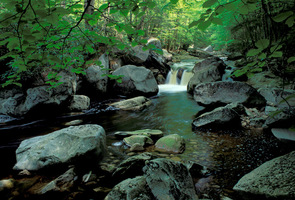 | Back to e-WV
| Back to e-WV
 The West Virginia Encyclopedia
The West Virginia Encyclopedia
 | Back to e-WV
| Back to e-WV
 The West Virginia Encyclopedia
The West Virginia Encyclopedia

The Otter Creek Wilderness Area is located in the Monongahela National Forest in Tucker and Randolph counties. This area lies in a bowl formed by Shavers Mountain to the west and McGowan Mountain to the east. The elevation of the wilderness area ranges from 1,800 feet at the mouth of Otter Creek to 3,900 feet on McGowan Mountain. Originally, the area consisted of 20,000 acres, but was increased when the Omnibus Public Land Management Act of 2009 authorized the purchase of an additional 698 acres.
The area was heavily logged by the Otter Creek Boom & Lumber Company from 1897 to 1914. The U.S. government acquired the majority of land in the Otter Creek area in 1917, for inclusion in the new Monongahela National Forest. Logging proceeded again from 1968 to 1972, when an effort began to have the area designated a wilderness area. Under the Eastern Wilderness Act passed by Congress in 1975, the area was given this designation. Otter Creek is one of five wilderness areas in West Virginia.
Otter Creek Wilderness Area provides recreation for hikers, campers, hunters, and cross-country skiers. The creek cascades over stones and around boulders, providing nature photographers numerous picturesque scenes. There are 45 miles of rugged, unblazed, unsigned trails. Most follow old railroad grades, logging, and farm roads where fallen trees are not removed. The longest trail and the main feature of the area is Otter Creek Trail, which is more than 11 miles long and crosses the creek three times. Numerous waterfalls, ranging from three to ten feet high, as well as swirling rapids can be found along the Green Mountain Trail. Hunting is permitted; mountain biking and motorized or mechanical equipment are not.
Otter Creek is home to a large population of black bear. Also abundant are wild turkey, white-tailed deer, snowshoe hare, cottontail rabbit, beaver, and grouse, along with a small number of brook trout and salamanders. Poisonous timber rattlesnakes are also found. Spruce trees dominate the higher elevations, with black cherry and yellow birch on the middle and lower slopes. A few apple trees remain, and Norway Spruce trees were once planted in an attempt to replace the harvested timber. The area receives more than 55 inches of precipitation each year, with heavy rains and deep snows not unusual. Frost may occur during any month of the year.
Written by Christopher Marsh